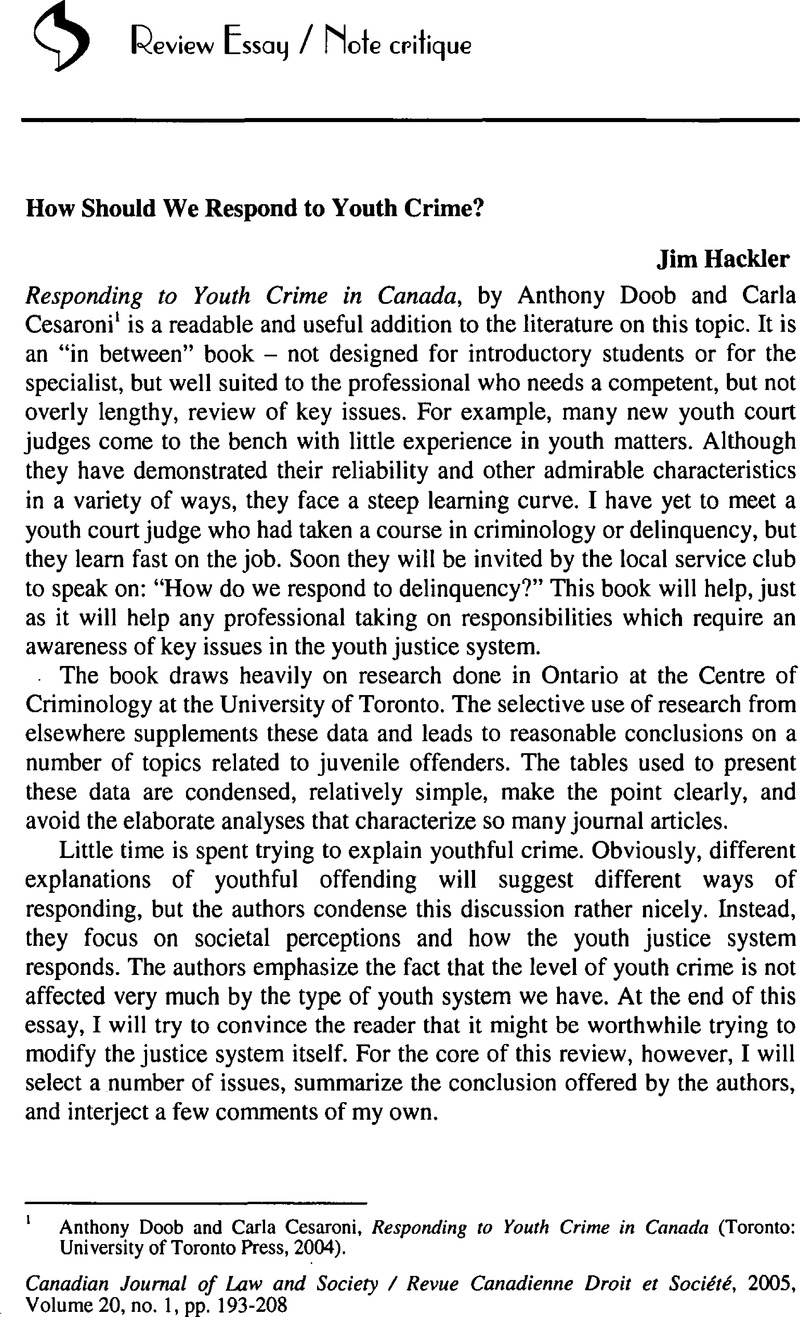No CrossRef data available.
Article contents
How Should We Respond to Youth Crime?
Published online by Cambridge University Press: 18 July 2014
Abstract

- Type
- Review Essay/Note critique
- Information
- Copyright
- Copyright © Canadian Law and Society Association 2005
References
1 Doob, Anthony and Cesaroni, Carla, Responding to Youth Crime in Canada (Toronto: University of Toronto Press, 2004).Google Scholar
2 Bala, Nicholas, Youth Criminal Justice (Toronto: Irwin Law, 2003).Google Scholar
3 Hackler, Jim, “An Impressionistic View of Canadian Juvenile Justice: 1965 to 1999” (2001) 20 Canadian Journal of Mental Health 2Google ScholarPubMed; see also Hackler, Jim, “Youth Justice and the Legal Process” in Uhlemann, Max & Turner, David, eds., A Legal Handbook for the Helping Professional (Victoria: Law Foundation of British Columbia)Google Scholar [Legal Handbook] [forthcoming].
4 Tibbets, S.G. & Piquero, A.R., “The Influence of Gender, Low Birth Weight, and Disadvantaged Environment in Predicting Early Onset of Offending: A Test of Moffitt's Interactional Hypothesis” (1999) 75:4Criminology 1222–45Google Scholar.
5 Gordon, Robert M., “Criminal Business Organizations, Street Gangs, and ‘wanna-be’ Groups: A Vancouver Perspective” (2000) 42:1Can. J. Crim. 39–60.Google Scholar
6 Tanner, Julian & Wortley, S., The Toronto Youth Crime and Victimization Survey: Overview Report (Toronto: Centre of Criminology, University of Toronto, 2002).Google Scholar
7 Gabor, Thomas, “Trends in Youth Crime: Some Evidence Pointing to Increases in the Severity and Volume of Violence on the Part of Young People” (1999) 41:3Can. J. Crim. 385–92Google Scholar.
8 Statistics Canada, Recidivism in Youth Court Histories, Part 1: The Likelihood and Rates of Recidivism 2000–2002 by Lee, N. (Ottawa: Department of Justice Canada, 2002).Google Scholar
9 Hillian, Doug, Reitsma-Street, Marge & Hackler, Jim, “Conferencing in the Youth Criminal Justice Act of Canada: Policy Developments in British Columbia” (2004) 46:3Canadian Journal of Criminology and Criminal Justice.CrossRefGoogle Scholar
10 Fox, James Alan, Trends in Juvenile Violence: A report to The United States Attorney General on Current and Future Rates of Juvenile Offending. (Washington, D.C.: Department of Justice, 1996).Google Scholar
11 Zimring, Frank, American Youth Violence (New York and Oxford: Oxford University Press, 1998).Google Scholar
12 Carrington, Peter J. & Moyer, Sharon, “Trends in Youth Crime and Police Response, Pre and Post-YOA” (1994) 36:1Can. J. Crim. 1–28.Google Scholar
13 Carrington, Peter, “Has Violent Crime Increased? Comment on Corrado and Markwart” (1995) 37:1Can. J. Crim. 61–73.Google Scholar
14 Legal Handbook, supra note 4
15 Conly, D., Patterns of Delinquency and Police Action in the Major Metropolitan Areas of Canada During the Month of December 1976 (Ottawa: Solicitor General, Canada 1978).Google Scholar
16 U.K., Howard League for Legal Reform, Banged Up, Beaten Up, Cutting Up: Report of the Howard League Commission of Inquiry into Violence in Penal Institutions for Teenagers under Eighteen (London: Howard League for Penal Reform, 1995) at 13.Google Scholar
17 Olds, D.et al., “Long-term Efffects of Nurse Home Visistation on Children's Criminal and Antisocial Behaviour.” (1998) 280 Journal of American Medical Association 1238–44.CrossRefGoogle Scholar
18 Hackler, James C., “The Manifest and Latent Functions of Legal Aid” (1992) 2:1International Criminal Justice Review 58–75.CrossRefGoogle Scholar
19 Hackler, James C., “Practicing in France What Americans Have Preached: The Response of French Judges to Juveniles” (1988) 34 Crime and Delinquency 467–85.CrossRefGoogle Scholar
20 Ibid. at 474–75.


